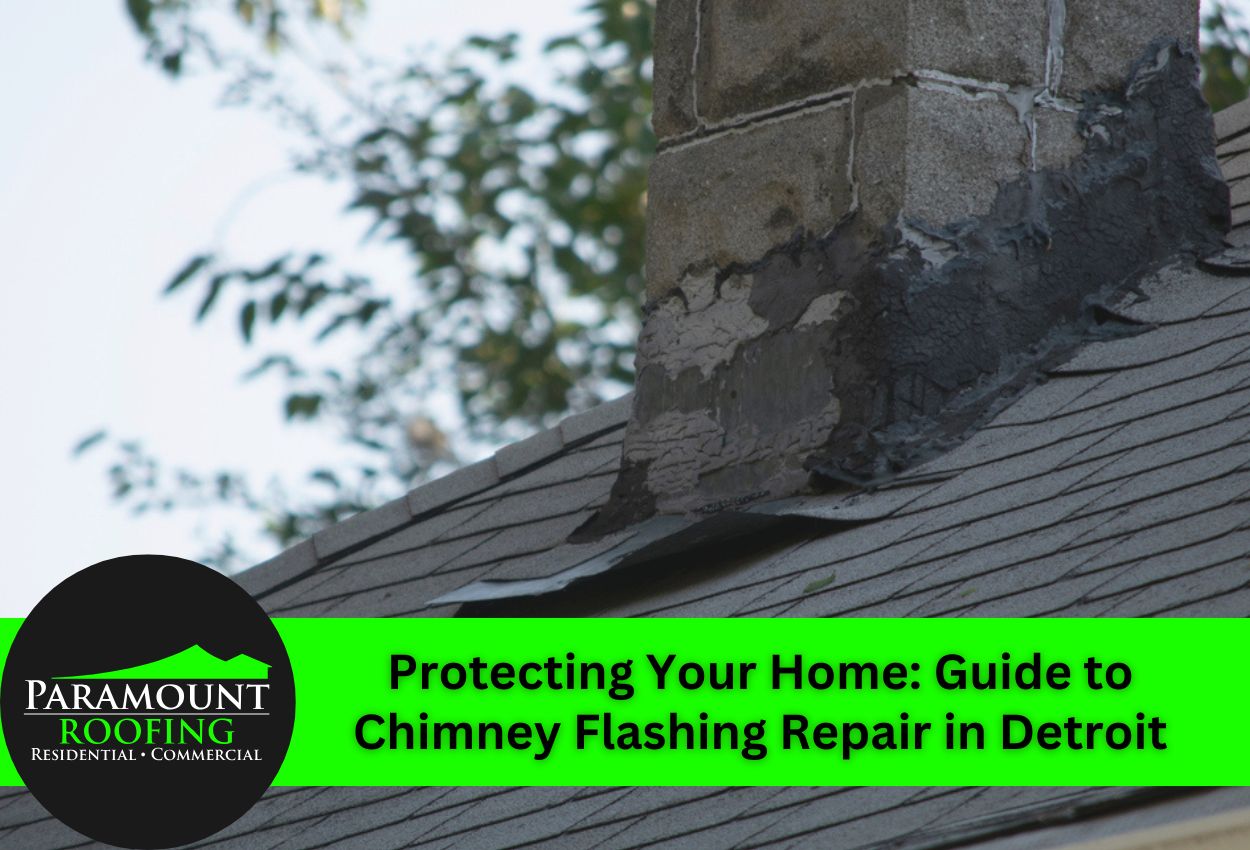For Detroit homes, one of the most vulnerable areas of your roof is the chimney flashing — the metal barrier designed to create a watertight seal between your chimney and roof. When this critical component becomes cracked or damaged, it opens the door to potentially serious water damage throughout your home.
Cracked chimney flashing repair ranks among the most important maintenance tasks for protecting your Detroit home. When left unaddressed, damaged flashing allows water to seep into your attic, walls, and ceiling during heavy rain and snowmelt. This infiltration can lead to mold growth, rotted wood, and compromised insulation, all issues that extend far beyond the chimney itself.
Recognizing the early signs of chimney flashing problems is crucial for Detroit homeowners. Water stains on ceilings near the chimney, rusty flashing material, visible gaps between the chimney and roof, or interior dampness after rainfall all signal potential flashing failure. Professional roof flashing installation and chimney flashing leak repair can prevent these warning signs from becoming major structural concerns.
With Michigan’s freeze-thaw cycles putting extra stress on roofing components, regular inspection and maintenance of your chimney flashing provides essential protection against water damage and preserves your home for years to come.
Understanding Chimney Flashing Damage: Causes and Identification
Michigan’s climate creates perfect conditions for chimney flashing deterioration. The Detroit area’s freeze-thaw cycles are particularly damaging, as water seeps into small cracks, freezes and expands, then thaws, gradually widening these openings. This cycle repeats dozens of times each winter, accelerating damage to even properly installed flashing. Heavy snowfall, ice dams, and spring storms with high winds further stress these critical roofing components.
To inspect your chimney flashing safely, begin by examining visible portions from the ground using binoculars. Look for rust streaks, warped metal edges, or visible gaps between the flashing and chimney brick. On a dry, calm day, carefully climb onto your roof to check for loose flashing pieces, separated seams, or missing caulk around the chimney base. Pay special attention to step flashing (the L-shaped pieces running up the chimney sides) and counter flashing (embedded in the chimney’s mortar joints).
Warning signs specific to Detroit-area homes include rust-colored staining on brick or masonry, white mineral deposits indicating water evaporation, and flashing that has pulled away from mortar joints. These issues require immediate attention to prevent water damage to your roof decking and interior spaces. Professional chimney flashing leak repair addresses these concerns before they compromise your home’s structural integrity and require more extensive roof flashing replacement services.
Should You Call a Professional for Chimney Flashing Repair?
Homeowners in Detroit can tackle some minor chimney flashing repairs themselves, but it’s important to know your limits. For temporary fixes, applying roofing cement to small cracks or replacing damaged caulking around flashing edges can provide short-term protection. These DIY solutions work best during dry seasons when you’re waiting for professional help or addressing very minor issues on newer homes with simple roof designs.
However, most chimney flashing leak repair situations call for professional expertise, especially in historic homes with complex roof lines and deteriorating masonry. Professional intervention is absolutely necessary if you discover rusted-through metal, flashing that has completely separated from the chimney, multiple leak points, or any issues requiring the removal and replacement of surrounding shingles.
Detroit homes built before 1970 typically have specialized flashing systems that require experienced handling during roof flashing replacement. Professionals bring the right tools, materials, and safety equipment to access steep roofs safely while ensuring proper installation techniques that prevent future water damage. They can also identify related issues like deteriorating mortar joints or chimney crown damage that might compromise even the best flashing repair.
While fixing damaged roof flashing might seem straightforward, chimney water damage prevention needs technical knowledge of how water moves across your specific roof design — expertise that professional Detroit roofers develop through years of local experience.
Step-by-Step Emergency Repair Techniques
When you discover a chimney flashing leak during one of Michigan’s unpredictable storms, taking immediate action can prevent extensive water damage to your Detroit home. Emergency repairs serve as your first line of defense until professional help arrives. Begin by clearing debris from the chimney base and surrounding roof area to locate the exact source of leakage, which often appears as damaged sealant, separated metal, or visible gaps.
For temporary waterproofing, roofing cement can be used for emergency protection. Apply it generously to visible cracks using a putty knife, pressing firmly to ensure even adhesion even in damp conditions. Self-adhesive flashing tape serves as another effective temporary solution. Clean the damaged area thoroughly, cut the tape to size, and apply it over the compromised section, overlapping existing flashing by at least 2 inches.
Detroit’s older homes often feature copper or galvanized steel flashing. For these materials, silicone-based sealants work best for emergency repairs, as they adhere well to metal surfaces and remain flexible during temperature changes. For newer constructions with aluminum flashing, polyurethane caulk provides superior temporary protection against Michigan’s freeze-thaw cycles.
Remember that these emergency chimney flashing leak repair methods typically last a few months, giving you time to schedule professional roof flashing replacement services. After applying temporary fixes, place buckets under interior leak points and monitor weather forecasts to prepare for additional protection during severe storms.
Complete Chimney Flashing Replacement Process
Professional chimney flashing replacement is a comprehensive process that ensures long-lasting protection for your Detroit home. The procedure begins with removing all existing flashing materials and thoroughly inspecting the surrounding roof and chimney structure for hidden damage. Experienced roofers will clean and prepare the surface, ensuring proper adhesion for new materials specifically selected to withstand Michigan’s extreme seasonal changes.
For optimal performance in Detroit’s climate, professionals typically recommend copper or stainless steel flashing due to their superior durability and resistance to corrosion. These materials may have higher upfront costs but deliver exceptional longevity under harsh conditions. For step flashing, roofers carefully install new pieces that interweave with shingles, while counter flashing is embedded into mortar joints to create a complete water barrier around your chimney.
Homeowners scheduling professional roof flashing replacement services should plan a day or two for the project, depending on chimney size and roof complexity. Preparation typically involves clearing the area around your chimney inside the attic and removing valuable items from the walls near the chimney. Most reputable Detroit roofing contractors will handle all necessary materials acquisition and cleanup, requiring minimal homeowner involvement beyond initial consultation and final inspection.
For the best results, schedule your chimney flashing replacement during dry weather, typically late spring through early fall, when Michigan offers more predictable conditions.
How to Prevent Future Chimney Flashing Failures
Protecting your chimney flashing from future failure requires a proactive approach, especially given Detroit’s changing weather conditions. Implementing a seasonal maintenance routine can extend the lifespan of your chimney flashing and prevent water damage. During spring, inspect for winter damage and clear debris that has accumulated. Summer inspections should focus on checking sealants that may have deteriorated from UV exposure, while fall maintenance involves clearing leaves and preparing the flashing for upcoming freeze-thaw cycles.
For Detroit homeowners seeking long-term solutions, upgrading to premium flashing materials offers significant advantages. Copper flashing, though more expensive initially, can last over 50 years and develop a protective patina over time. Stainless steel provides excellent durability at a mid-range price point. For optimal performance, consider two-piece flashing systems with base flashing and counter flashing working together to create superior protection against water infiltration.
Modern installation techniques have also evolved to better protect against Michigan’s severe storms. Professional roof flashing installation now often includes creating expansion joints that accommodate thermal movement during temperature swings. Additionally, high-performance sealants designed specifically for chimney applications offer better adhesion and flexibility throughout seasonal changes. These preventative measures provide the comprehensive chimney water damage prevention that Detroit homes require for lasting protection against the elements.
Integrating Chimney Repairs with Overall Roof Maintenance
A comprehensive approach to roof maintenance must include attention to chimney flashing. For Detroit homeowners, coordinating chimney flashing repair with broader roof maintenance creates a more effective and affordable strategy for protecting your home. When scheduling roof inspections or repairs, always include a chimney flashing assessment to identify potential weaknesses before they develop into serious problems. Many Detroit roofing contractors offer combined service packages that address multiple roofing components during a single visit, saving both time and money.
The connection between chimney flashing and your overall roofing system is critical. Damaged flashing can undermine even new shingles by allowing water to leak beneath them. Similarly, aging shingles around your chimney can stress and damage otherwise sound flashing. Professional roof flashing installation should always consider how water flows across your entire roof, especially in homes with complex architectural features that direct runoff toward chimneys.
Long-term protection requires both professional oversight and homeowner vigilance. Schedule professional inspections of your entire roofing system, including chimney flashing, at least every two years or more frequently for homes over 20 years old. Between professional visits, perform visual checks after major storms, looking for displaced flashing or new water stains near your chimney. This balanced approach to chimney water damage prevention extends the lifespan of both your flashing and entire roofing system, providing maximum protection for your Detroit home.
Expert Cracked Chimney Flashing Repair in Detroit
If you’ve noticed signs of wear or damage to your chimney flashing, it’s crucial to repair it as soon as possible to prevent serious water damage to your home. In Detroit’s challenging climate, the integrity of your chimney’s flashing is vital for protecting your home against the elements. Waiting too long can lead to extensive and expensive repairs.
At Paramount Roofing, we specialize in diagnosing and repairing cracked chimney flashing effectively and efficiently. Our team of experts is equipped to handle everything from minor repairs to complete flashing replacements, ensuring your home remains dry and damage-free.
Call Paramount Roofing today at (586) 690-0227 to schedule your chimney flashing repair with professionals who care about your home.
 Free Estimate
Free Estimate
 Request Service
Request Service Locations
Locations 
